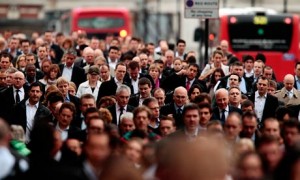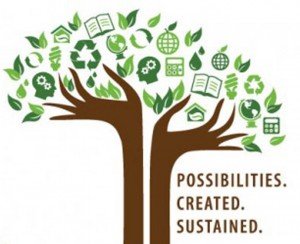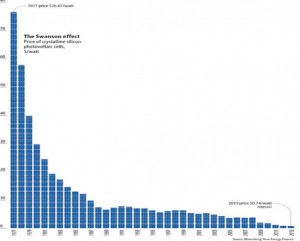 Slow down for a moment - THINK! Do we really need all these THINGS?
Slow down for a moment - THINK! Do we really need all these THINGS?
Our society is completely engulfed by consumerism. Companies are focusing on unlimited growth and production. There is massive propaganda convincing us to consume – consumption is good for profits, is good for the political establishment, is good for its own sake. Advertisements displayed at every corner persuade us to purchase new products. New iPhone. Thinner. Bigger. Faster. Better. Producers design their products so they break down right after the warranty period and force us to buy new ones. Each year human beings living in developed countries produce tones of rubbish, consume millions watts of non-renewable energy and pollute millions litres of water. It is deeply concerning that we are capable of destroying almost every element of the biosphere. It is even more concerning where are we going to live if the Earth is transformed into a gigantic rubbish dump as result of our irresponsible actions. How long will it take before we realize that the biosphere has its limits? What if the problem was not the lack of the newest iPad, but scarcity of drinking water? Whilst nature does not really need us, we are entirely dependent on nature and its resources. We strive without reflection to consume and poses more. We need to realize it is the final call to stop thinking in such short perspective and change our paradigm that unlimited growth and consumption is good.
Human beings subjugated the Earth
“Destruction of the environment is not only rational; it’s exactly what you’re taught to do in college. If you take an economics or a political science course, you’re taught that humans are supposed to be rational wealth accumulators, each acting as an individual to maximize his own wealth in the market. The market is regarded as democratic because everybody has a vote. Of course, some have more votes than others because your votes depend on the number of dollars you have, but everybody participates and therefore it’s called democratic. It follows that if there are dollars to be made, you destroy the environment. The reason is elementary. The people who are going to be harmed by this are your grandchildren, and they don’t have any votes in the market. Their interests are worth zero. Anybody that pays attention to their grandchildren’s interests is being irrational, because what you’re supposed to do is maximize your own interests, measured by wealth, right now. Nothing else matters.”
Noam Chomsky: linguist, philosopher, activist
It is the careless, uninhibited growth which pollutes our environment and is destroying our planet. Whilst disregarding the existence of alternative sources of energy, recycling and other sustainable solutions, it focuses on maximizing profit with no consideration for environmental costs. Inevitably, the capacity of the natural environment to absorb and detoxify waste is limited. Those who will pay for our uninhibited growth and consumerism are our children. They will be left with no alternatives – living on a polluted planet with scarcity of natural resources like clean soil, good quality water. It is even predicted that the third world war can start as a result of shortage of water supply. Another problem is the oblivion of existence of developing countries, which constitute 2/3 of the world population and practically do not exist in any economical speculations. We should be conscious that what we do in Spain today can contribute to the lack of drinking water in Africa tomorrow. The future welfare lies in our current decisions.
A solution to this problem is sustainable development. Its goal is to achieve an equilibrium with basic ecological support systems. Sustainability is the endurance of natural systems. Sustainable development includes four principle interconnected domains: ecology, economics, politics and culture. It assumes to enable the same access to natural resources for upcoming generations – in fact this should be a basic human right. Doubtlessly, healthy ecosystems and uncontaminated environments are necessary for our survival. There are a lot of ways of reducing negative human impact: sustainable architecture, environmental resources management, environmental protection, to name just a few.
Parable about a happy pauper and a distressed nabob
I believe that growth and striving to achieve the maximum profit doesn’t necessarily make people happy. To illustrate this, I would like to tell a story of two different types of people I met last summer. In July last year, I went trekking to Nepal. One day, I was passing through a small village, in the mountains practically cut off from the rest of the world. The houses there were very simple, made of clay and rock. They had no electricity. I wondered – how can people live here. It was raining and I was completely soaked. A young woman standing in the entrance of a modest house, waved to me with a gesture of invitation, trying to show that I can hide there from the rain. I entered the house. What I saw inside wasn’t even what we consider as Existenzminimum. One room with a fireplace in the center and a hole in the roof for smoke. Self-made furniture, sacks filled with dried leafs serving as mattresses. The woman treated me with the content of a pot standing on the fire. It seemed to be hot water with melted yak butter. For me, it was disgusting, but all the family drank it as it was a real treat. In the room there were three children and their grandmother, all watching me with the great interest, trying by all means to communicate with me, smiling all the time. These people seemed to be very happy, despite their modest welfare.
Two weeks later I was in the London subway listening to two elegant woman conversing in packed and busy Canary Wharf station. It was 10 pm, they were both lawyers, in their late thirties – just left from work. They were complaining of being single, that they have no energy or time to meet anyone. Doubtlessly, in their designer apartments they had everything provided for a comfortable life, but despite this fact they did not seem happy. I have no doubt who was happier in life – the Nepalese woman from the mountain village or the women from Canary Wharf station.
This shows that there is no direct link between growth and consumerism, and happiness in life. I am far from saying that we should change to a dramatically primitive, anti-consumer lifestyle. I just want to say that we should analyze more carefully what do we really need in life and what makes us happy in the long-term perspective.
How to develop without destroying?
There are a lot of solutions to make our world more sustainable. We can do so by replacing non-renewable resources with renewable resources of equal or greater value without degrading or endangering natural biotic systems.
In my opinion the great power for increasing the level of sustainability is in average habitants and their lifestyle. Moving towards sustainability is a social challenge. It involves among others individual lifestyles and ethical consumerism, as well as architecture, urban planning, transport solutions or national law. Ways of living more sustainably can take many forms from rethinking of our cities, reappraising economic sectors or architecture, using science to develop new technologies, to adjustments in individual lifestyles to conserve natural resources.
Why not?
“Two percent of people think,
Three percent of people think that they think,
And ninety-five percent of people would rather die than think”
George Bernard Shown
I believe the biggest problem is that majority of people simply do not think about possible environmental impact while making their everyday decisions. Standing in a shower we decide if we do it for 3 minutes, using 30 liters of water, or 10 minutes, increasing the consumption to more than a 100 liters. We also can choose between using reusable material bags for shopping or taking single-use plastic bags. These kind of decisions are waiting for us every moment of our average day.
We should be aware of the effects caused by our everyday decisions. In my opinion, what could change people lifestyle to a more sustainable development is education in area of sustainable living. I believe that if the people were aware of the significance of their everyday decisions and the enormous scale of damage they can cause (water crisis, energy crisis, food crisis), they would gradually start changing their behaviour.
I believe that what can change human mentality is media. If we promote “ecolifestyle” and make it trendy, there is a big chance it will gain popularity. Fashionable consumerism would change to fashionable “ecolifestyle”.
The profession strongly associated with anti-sustainability is the developer. Developers are generally interested in short term profitability. Their target is to make profit NOW, while their customers are usually interested in purchasing at the low possible price. Sustainable solutions are usually more expensive. However, in the longer term perspective the higher price will pay back itself in the future. The problem is in convincing people to pay more money now and have positive long-term effects in the future.
The economics of sustainability is based on a different belief system – a belief that short-run maximization of profits and individual consumer satisfaction ultimately will deplete both the natural and social resources upon which human well-being and survival of the species depend.
Toward an economics of Sustainability, John E. Ikerd
Above diagram shows the example of solar panels’ significant price decrease in the years 1977-2013. I hope the fact that prices for sustainable solutions are decreasing will gradually bring in more users.
Social role of architects
As an architect, I strongly believe that design practices have a meaningful, proactive, and transformative impact on driving factors that shape current urban realities and architecture. Forward-looking architecture should shape our cities. In the shadow of environmental degradation it will become a necessity in the future, but we should start putting it into practice already now.
Architects should design buildings as if they were complex ecosystems, considering social needs and elements like using local materials, green and self-sufficient technology, etc.
Projects should be treated as integrated concepts in strategic planning from micro to macro level taking into account ecological, economical, political and cultural issues. The optimal development is the one that meets the needs of the present, being aware of environmental limitations and without compromising the ability of future generations to meet their own needs,.
Another profession playing a significant role in this area is urban planning. Urban regulations influence the level of sustainability during designing. For example, in my home city: Warsaw (2 million of habitants) few years ago a law was established that minimum 50% of path surface has to be a biologically active area. This regulation limits developers and increases green areas in the city. It’s a good example of regulations limiting the developers and having a positive effect on sustainability. Design process resulting in creation of high-quality sustainable space has a positive impact not only on economic issues like land value or reducing energy costs, but also on social issues, e.g. productive workplaces, healthy environment and childhood development.
Conclusions
The rules of the sustainability are the laws of nature. A desirable quality of life cannot be achieved if the laws of nature are violated. Human species should be aware of consequences of environmental degradation and should understand that development is not always synonymous with growth. To achieve sustainable well-being we have to consider our everyday decisions thinking of their long-term consequences. We have to change our paradigm that consumption is always good. One of the basic rights that people should have is access to natural resources for upcoming generations. Sustainable architecture is not stand alone but has to create synergy, must enter into a dialogue with ecology, economics, politics and culture.




